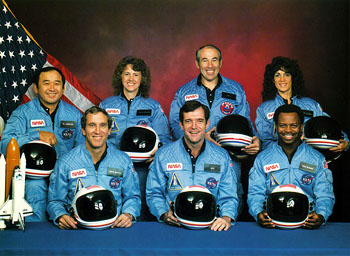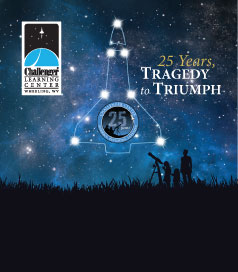
Challenger Plans 25th Anniversary Event
Thu Jan 20 2011

The crew of the space shuttle Challenger.
On a frigid Florida morning 25 years ago, Jan. 28, 1986, the crew of the space shuttle Challenger was lost shortly after launch as many Americans—including millions of schoolchildren—tuned in to watch this historic mission begin as it carried the first teacher in space, Christa McAuliffe. The tragic explosion that claimed McAuliffe and her six crewmates struck at the souls of people around the world.
President Reagan specifically mentioned those schoolchildren in his speech to the country that night:
"I know it is hard to understand, but sometimes painful things like this happen. It's all part of the process of exploration and discovery. It's all part of taking a chance and expanding man's horizons. The future doesn't belong to the fainthearted; it belongs to the brave. The Challenger crew was pulling us into the future, and we'll continue to follow them."
Reagan's words about the crew's legacy were prophetic. From the ashes of the tragedy rose a living, lasting monument to the Challenger crew. The families of the seven astronauts later that year founded the Challenger Center for Space Science Education, its directive dedicated to continuing the educational spirit of the last Challenger mission by developing Challenger Learning Centers worldwide to engage students in science and mathematics education.
In 1994 a Challenger Learning Center opened on the campus of Wheeling Jesuit in the then new Erma Ora Byrd Center for Educational Technologies building. On Jan. 28 at 6:45 p.m. the Wheeling Challenger Center is hosting an event to remember the anniversary of the Challenger tragedy and to celebrate the legacy of the mission by showcasing all that the Wheeling facility offers.

Also speaking at the event will be three of the Rocket Boys, the West Virginians immortalized in the book, The Rocket Boys, and the movie, October Sky, about a group of teens whose experiments with homemade rockets earned first prize in national science fair and propelled them into distinguished careers in science from their humble beginnings in a small mining town. Billy Rose, Roy Lee Cooke, and Jimmie O'Dell Carroll will talk about the Freida J. Riley Teacher Award, given each year in honor of the educator who inspired the Rocket Boys on their quest.
In addition, Dr. Chuck Wood, director of the Center for Educational Technologies, will discuss his role on the Challenger mission. At the time Wood was chief of NASA's Space Shuttle Earth Observations Office. He trained the Challenger crew on making observations of the Earth during their time in space. Wood helped Christa McAuliffe prepare a lesson she was to teach from space, and McAuliffe called him the day before the launch to review the lesson.
The Wheeling Park High School chorus and quartet will perform as well.
Attendees will also tour the Challenger Learning Center—one of 48 worldwide— and learn about the kinds of missions the center's many flight directors lead. The tour will also unveil the new Micronauts facility for children 5 to 8 years old.
"After the Challenger tragedy unfolded, the astronaut family members realized that Challenger's mission—a mission to teach—was incomplete," said Jackie Shia, director of the Challenger Learning Center in Wheeling. "Lessons were left untaught. Scientific and engineering problems were left unsolved. We lost the chance to have an impact on students and inspire a new generation of explorers. If we didn't somehow continue Challenger's mission, then their loved ones would have died in vain. This became the driving force behind the creation of the Challenger Learning Centers."
In its early years the Challenger Learning Center flew missions in rooms transformed to mimic NASA mission control and the space station, inviting middle school students to get a taste of what it's like to work in space on fast-paced science experiments.
During a two-hour mission participants serve on one of eight teams in mission control or on the space station. Merging the power of imagination with the excitement of discovery, students become engineers and scientists as they simulate a space mission. The experience provides students along with teachers and adult learners with simulations that emphasize teamwork, problem-solving, decision-making, and communication skills.
"Later, the Wheeling Challenger Center developed a way to reach out to students across our state," Shia said. "Seeing that students from Southern West Virginia could not make the trip to our center, we wanted to see how we could take the simulation through a phone line. We really had no idea that we would be taking it across the United States as well as around the world."
Challlenger's e-Missions™ are distance learning videoconference simulation in which students connect with a flight director at the center and use their problem solving skills and math and science abilities to work their way through a scenario fraught with crises. Each year more than 750 video connections are made to classrooms around the world. In fact, e-Missions have now been delivered to 14 countries in addition to the United States. The Wheeling center has been honored nine years for having served the most children of all the centers.
An estimated 275,000 students have flown Challenger missions either on site or via videoconference since 1994. President George W. Bush even took part in an e-Mission in 2004 while visiting a school in Pennsylvania.
All told, the Wheeling center reaches around 30,000 students each year. That number will soon grow with the grand opening of the Micronauts program on Jan. 28. Wheeling will be the only Challenger Center whose Micronauts program has its own exhibit hall. This colorful and vibrant exploratorium invites younger children—those in grades K-2—to experience a variety of hands-on activities that will spur their interest in science and math and the joy of learning.



